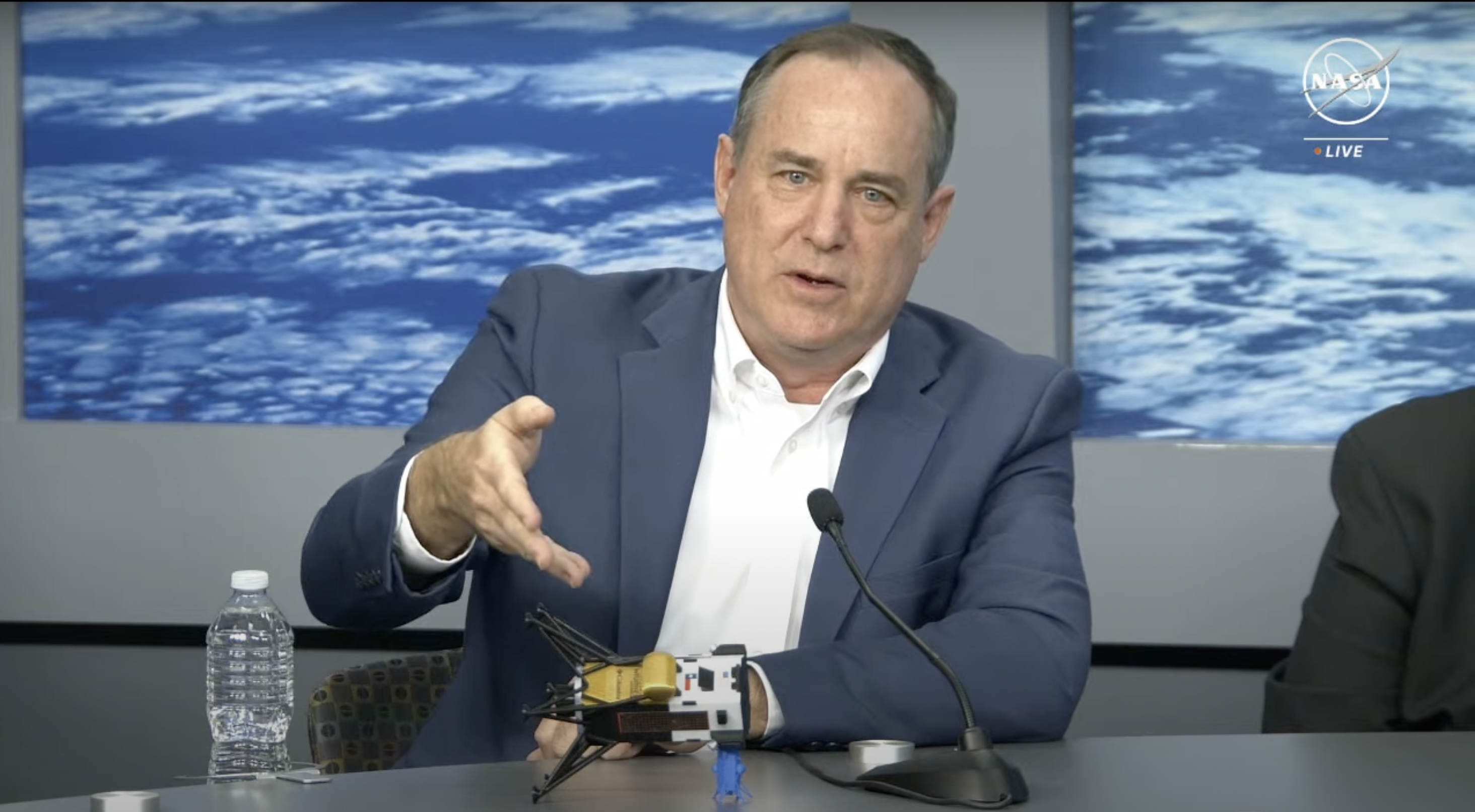Intuitive Machines’ spacecraft touched down yesterday on the lunar surface . . . sideways. CEO Steve Altemus confirmed during a press conference Friday that, while it wasn’t a perfect landing, it’s nothing short of a miracle the spacecraft landed intact at all.
Using a small model of the lander, Altemus demonstrated how engineers believe the spacecraft, called Odysseus, made its descent given the most recent telemetry data.
“The vehicle is stable near or at our intended landing site,” Altemus said. “We’re downloading data from the buffers in the spacecraft and commanding the spacecraft.”
Intuitive Machines confirmed yesterday that the lander touched down on the surface at 5:24 p.m. Central Time — making the company the first to put a privately built spacecraft on the moon — but many details about the vehicle’s health were unknown. Part of the reason for that is because the onboard camera, an instrument called EagleCam, was powered down during landing. Without images, engineers had to rely on other data to determine the lander’s orientation after it landed.
Even now, the company is continuing to reconstruct the series of events that led up to the historic landing. The company originally thought Odysseus was actually upright, but Altemus said that was based on “stale” telemetry data. Currently available information is indicating that the spacecraft was indeed vertical at touchdown, but because it was also moving horizontally — and a little too quickly — it’s likely that one of its legs caught on something or broke, causing it to tilt over.
The good news is that most of the onboard payloads are not on the downward-facing panel — the only one that does not need to operate on the lunar surface. The company was able to confirm that many of the major subsystems — including the solar arrays providing power to the spacecraft and the onboard payloads — are performing well.
Much of the mission’s success came down to very quick thinking by Intuitive Machines’ mission controllers — and just a stroke of very good luck.

Intuitive Machines CEO Steve Altemus during a press conference after the IM-1 landing. Image Credits: NASA
The navigational issues started after Odysseus conducted a planned maneuver called lunar orbital insertion on Wednesday night, which put it in an elliptical orbit around the moon. That ended up being extremely “fortuitous,” Altemus said, because it led mission controllers to try to use a navigational subsystem called “laser rangefinders” far earlier than planned (the lasers were going to be activated for the first time during the final descent phase).
After reviewing the data, the company realized the morning of landing that the lasers were not working — because they did not turn off a physical safety switch on the component while it was still on the ground.
These lasers determine critical variables for landing, like altitude and horizontal velocity; with them non-functional, Odysseus could’ve succumbed to the fate of so many other landers and crashed on the surface. The company considered a handful of options, but ultimately they decided to use a NASA doppler lidar payload that was meant as a technology demonstration. They directed Odysseus to orbit the moon for an additional two-hour period, to give them more time to load software patches and reset the lander’s guidance, navigation and control system.
It was a remarkable last-minute save. Prasun Desai, deputy associate administrator of NASA’s space technology mission directorate, said during the press conference that the agency was hoping to get the doppler lidar technology to a technology readiness level (TRL) of 6, but that the successful execution onboard Odysseus has brought it to TRL 9, the highest level of readiness.
“All that hard work came to bear yesterday when there was a technical issue and the teams decided that hey, it was best to try to do the switch and rely on this tech demonstration,” he said. “Everything we understand from the telemetry received, which is limited to this point, until we get all the data back, is that the technology performed flawlessly.”



/cdn.vox-cdn.com/uploads/chorus_asset/file/25321822/STK174_PRES_BIDEN_C.jpg?w=145&resize=145,100&ssl=1)

/cdn.vox-cdn.com/uploads/chorus_asset/file/24397982/DSC04210_processed.jpg?w=145&resize=145,100&ssl=1)

/cdn.vox-cdn.com/uploads/chorus_asset/file/25824833/STKB309_WATCH_DUTY_B.jpg?w=145&resize=145,100&ssl=1)
Leave a Comment